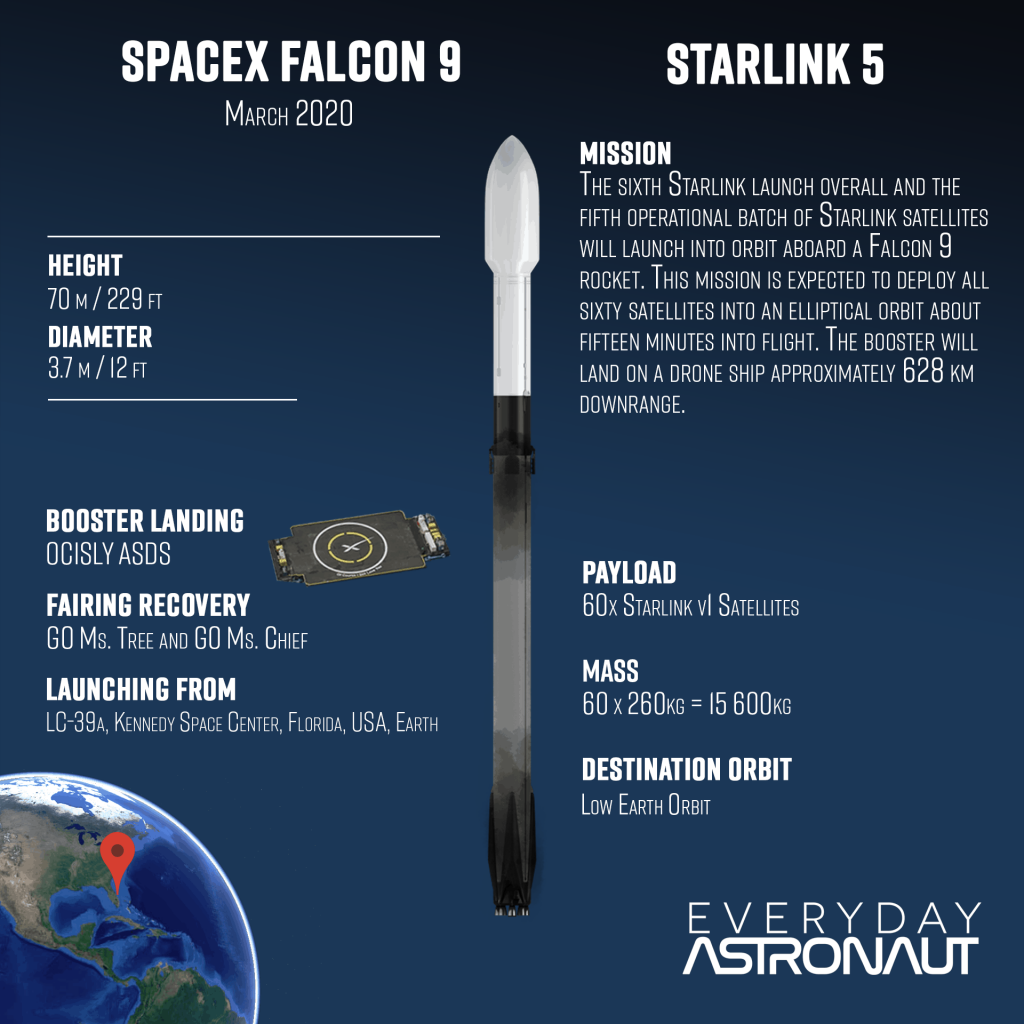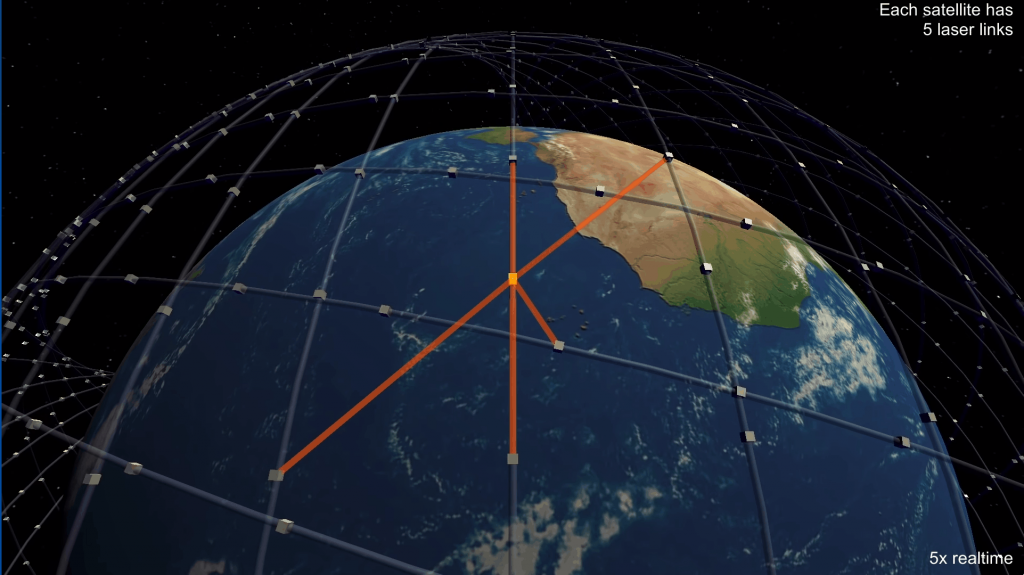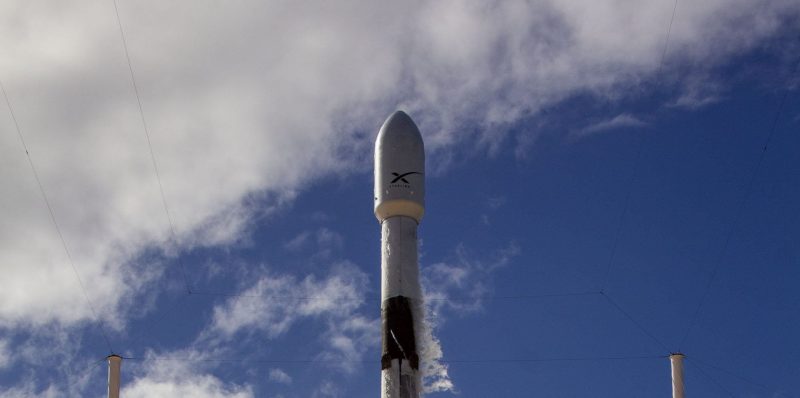What’s All This About?
SpaceX’s Starlink 5 mission, launching from Kennedy Space Centre, will fly 60 Starlink satellites into orbit atop of its Falcon 9 rocket. This will be the fifth operational launch of the company’s near-global satellite constellation – Starlink, which aims to deliver a fast, low-latency internet service to locations where access has previously been unreliable, expensive, or completely unavailable.
The company plans to offer service in North America by the end of 2020 and estimates that once complete, its venture will make $30-50 billion annually. The funds from which will, in turn, be used to finance its ambitious Mars program.
Lift Off Time
|
March 18, 2020 | 12:16 UTC
(8:16 a.m. EST) |
|---|---|
Mission Name and what it is |
Starlink 5, fifth Starlink v1.0 launch |
Launch Provider
|
SpaceX |
Customer
|
SpaceX |
Rocket |
Falcon 9 Block 5 (B1048.5) |
Launch Location |
Launch Complex 39A (LC-39A) at Kennedy Space Center, Florida |
Payload mass |
15,600 kg (60 x 240 kg) |
Where are the satellites going? |
Low Earth Orbit 550 km (initially 290 x 386 km) |
Will they be attempting to recover the first stage? |
Yes |
Where will the first stage land? |
628km downrange aboard SpaceX’s drone ship Of Course I Still Love You |
Will they be attempting to recover the fairings? |
Yes, SpaceX’s humorously named fairing-catcher vessels are in position. |
Are these fairings new? |
No, both fairing halves were recovered from the water by GO Searcher and GO Navigator after the first (non-operational) Starlink launch in 2019. |
This will be the: |
|
Where to watch |
SpaceX Livestream
Tim Dodd, the Everyday Astronaut, will be streaming at T-30 minutes; come ask questions and join the conversation live! If you happen to be in the area, here’s where you can watch in person! |
Mission Overview
After boosting the second stage along with its payload towards orbit, the first stage will perform an entry burn to slow the vehicle down in preparation for atmospheric reentry. The booster will then land 628km downrange aboard autonomous spaceport drone ship Of Course I Still Love You. SpaceX will also attempt to recover both fairing halves with their humorously named fairing-catcher vessels: GO Ms. Tree and GO Ms. Chief.
The flight-proven booster supporting this mission (B1048.5) has been in service since July 2018. It previously flew on Iridium NEXT-7, SAOCOM 1A, and most notably, the Nusantara Satu/Beresheet lunar lander mission in February of 2019. Most recently, the booster flew the Starlink L1 mission, becoming the first to be flown four times.
This launch will break the previous record by becoming the first orbital-class booster to fly five times, marking the halfway point in SpaceX’s design goal of reusing each Block 5 booster ten times with little-to-no refurbishment.

What Is Starlink?
Each Starlink satellite is a compact design that weights 260 kg. SpaceX developed them to be a flat-panel design to fit as many satellites as possible within the Falcon 9’s 5.2 meter wide payload fairing. 60 satellites fit into a dispenser affixed to the second stage. The entire Starlink payload weights around 15,600 kg. That’s near the limit that a Falcon 9 can lift into LEO and still have enough propellant for landing.
For such small satellites, each one comes loaded with high-tech communications technology. There are six antennas, four high-powered phased-array and two parabolic ones that all support high-speed data throughput. Starlink also features a SpaceX built and designed star track navigation system to enable precision placement of broadband throughput.
Four inter-satellite laser links (ISLLs) allow high-speed communication between Starlink satellites. SpaceX placed two ISLLs on the front and rear of the satellite to talk with Starlink satellites in the same orbital plane. They remain fixed in position. Two ISLLs on the satellite’s sides track other Starlink satellites in different orbital planes. This means they have to move to track the other satellites.
Ion Power
Innovative ion propulsion technology keeps these satellites in the correct position while on orbit. They use ion Hall-effect thrusters to achieve their working orbit, to maneuver while on-orbit and, at end of life, deorbit them. According to SpaceX, Starlink is the first krypton propelled spacecraft ever flown.
Becoming space junk is not in the cards for these satellites. Each Starlink satellite incorporates an autonomous collision avoidance system. It uses the Department of Defence’s debris tracking data to avoid colliding with space debris or other satellites. When they come to the end of their useful life, they will deorbit and completely burn up in the Earth’s atmosphere.

How Will Starlink Work?
To achieve initial coverage, SpaceX plans to form a net of 12,000 satellites, which will operate in conjunction with ground stations, akin to a mesh network. Furthermore, the company recently filed for FCC permission on an additional 30,000 spacecraft, which, if granted, could see the constellation amount to a lucrative 42,000. This would octuple the number of operational satellites in earth orbit, further raising concerns regarding the constellations effect on the night sky and earth-based astronomy. However, Musk has stated that he is “confident that we will not cause any impact whatsoever on astronomical discoveries,” and is working with industry experts to minimise the potential for any impact. More information is available on the Starlink website






Thanks for the Info, always good to check out before a launch
Don’t know if anyone noticed during the aborted launch yesterday March 15, 2020, that the water suppression system failed to shower the pad.
The water deluge system definitely worked, seen as we could see the steam cloud created by the short duration firing of the Merlins.
Maybe no one noticed that a water leak from the water tower starts at T-2:00 in the count down. A huge leak appears to develop in the middle left of the screen before Spacex breaks away to the launch pad view. It’s at T-10 seconds that the water suppression system should be heard rushing water to the launch pad shower heads. Water should be seen seconds later showering the launch pad with water. So where’s the water?
I mean, I don’t know I’m just a carpenter. Anybody a plumber?
Here’s the link:
Did anyone else see the object go past the first stage just prior to re-entry burn T+ 00:06.39
Any ideas what it was?
Why didn’t they land the Booster B1048.5 on (of course i still love you)? What happened that the booster could not land? Was the (of course i still love you) not in the right place or did the booster run out of fuel?
Tim I want to thank you for your explanation of space travel and what is happening in space. I learn something every time. Keep it up, you are doing well.
Kind regards Sebastiaan from the Netherlands.
This booster (B1048.5) had an engine go out on assent (engine redundancy DOES have substantial value, making this mission a success). It appears as though that engine was one that does the entry burn, and the booster (unable to use that engine) drifted too far into the atmosphere for the grid-fins to be able to make up for the higher velocity.